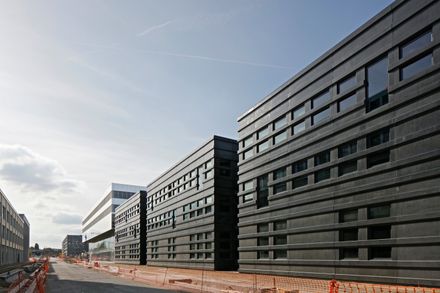Lab City CentraleSupélec
COMPETITION TEAM
Fred Awty, Felicity Barbur, Clément Blanchet, Eugenio Cardoso, Alicia Casals, Phil Handley, Helena Hiriart, Li Huang, Didzis Jaunzems, Sangwoo Kim, Pierre-Jean Le Maitre, Maria Aller Rey, Ida Stople
ARCHITECTURAL SUPPORT
Clément Blanchet Architecture
ARCHITECT IN CHARGE
Ellen Van Loon, Rem Koolhaas
LANDSCAPE
D'Ici Là
DESIGN DEVELOPMENT
Clément Blanchet, Edouard Pervès, Saskia Simon (Project Architects); Pedro Pitarch, Alonso Anton, Anikeev Tolis Apostolidis, Gabriella Bandeira, Lourdes Carretero Botran, Jonathan Bourhis, Matthieu Boustany, Paloma Bule, Eugenio Cardoso, Alban Denic, Gilles Guyot, Christopher Hayman, Aleksandar Joksimovic, Cristina Martin de Juan, Min Hong, Khor Sangwoo, Kim Lina Kwon, Pierre-Jean Le Maitre, Elida Mosquera Martinez, Ioana Mititelu, Edmondo Occhipinti, John Paul Pacelli, Marcus Parviainen, Maria Aller Rey, Ana Rubin, Kristin Schaefer, Jad Semaan, Timur Shabaev, Saul Smeding, Lingxiao Zhang
ENGINEER
Bollinger+Grohmann, ALTO Ingénierie, DHV
MODELS
Vincent de Rijk
IMAGENERY
Artefactory
MANUFACTURERS
Bandalux
CONSTRUCTION
Edouard Pervès (Project Architect); Mauro Altana (Site Manager); Joanna Fregnac, Glaucia Hanne, Cristina Martin de Juan, Iris Maass, Pierre-Jean Le Maitre, Vitor Oliveira, Saskia Simon
CONSULTANTS
Apex Brian Cody, Dal, Ducks, Cuisine Et Concept, Polygraphik
Text description provided by architect.
In an era of privatization, cities are facing a major challenge: investment in the public domain depends increasingly on the private sector.
As a result of this reframing of the collective agreement, the role of architecture is often reduced to the visual impact of its shape and surface rather than contributing to a new educational, social and civic dimension.
The competition launched by the Ecole Centrale Paris for the design of a new engineering school has become the perfect opportunity to explore ways to answer this demanding challenge.
Laboratories are typically planned as linear buildings, a large box divided by endless corridors.
Such a typology creates a “blackout” of the urban conditions; the building becomes a gigantic wall due to its extremely isolated and internalized programs.
We can instead imagine laboratories as a collection of discreet parcels in an open plan grid; in this way, a city can accommodate endless configurations of programs and activities.
This method provides a stable framework for constantly changing requirements; the program may be reconfigured or intensified as necessary.
This re-contextualization implies freedom to formulate new types of learning styles that promote community, plurality and diversity of the population within a dense field of knowledge, while ensuring the pure operation of the engineering school as an educational incubator.
OMA’s design integrates urbanism with the school, supplanting the previous homogeneous experience
of the campus.
The architecture of the Lab City generates an open urban school, with creative disorder framed under a structural skeleton.
By creating a main street, cutting diagonally across the Lab City, the design allows a seamless experience between the building and its surroundings, providing a convenient public route between the future heart of the neighbourhood and the future subway station.
Around this urban spine, the program is spread in different buildings of various typologies and sizes, organized on an urban grid served by secondary streets.
A unique lightweight roof covering the entire complex completes the scheme by creating a strong link between the different buildings and allowing “external” protected spaces to be used freely all year long.


































